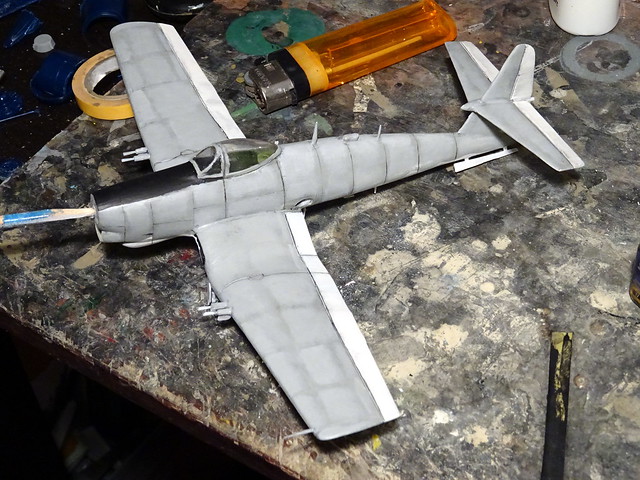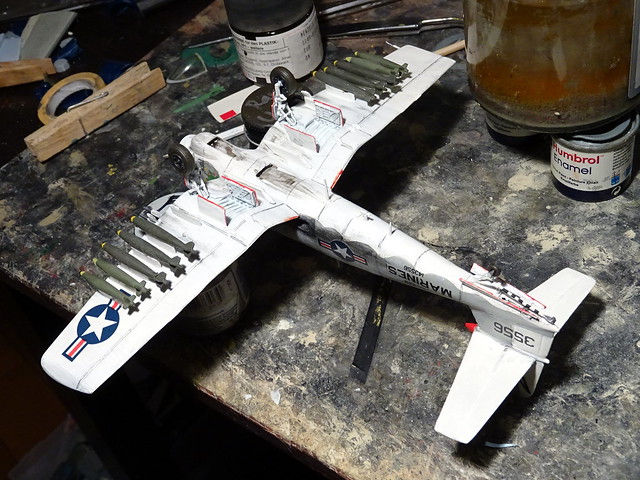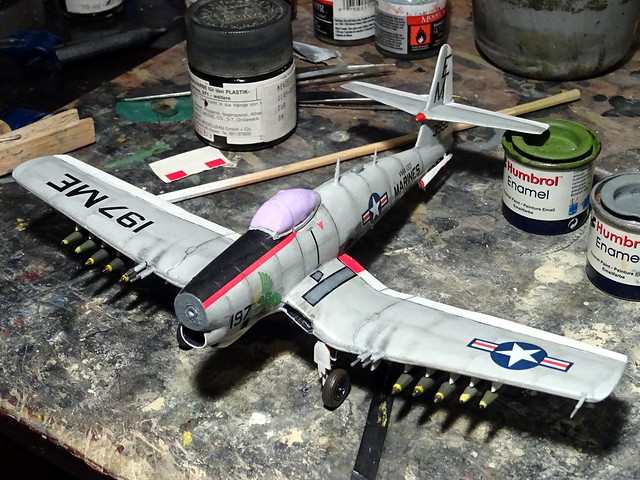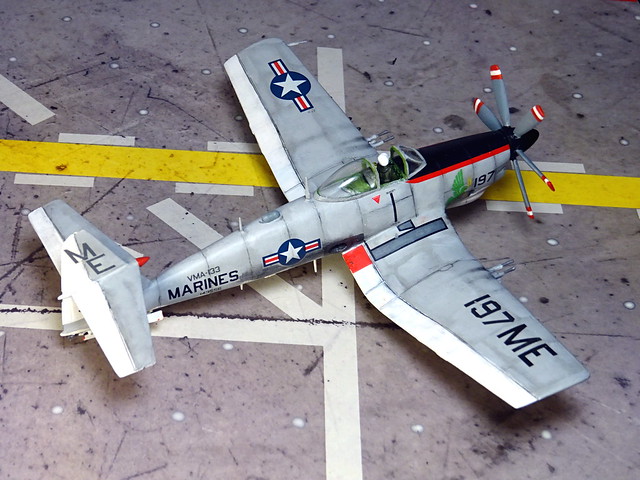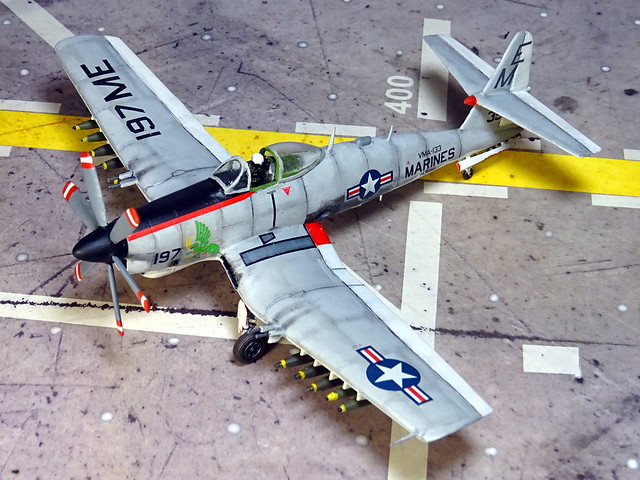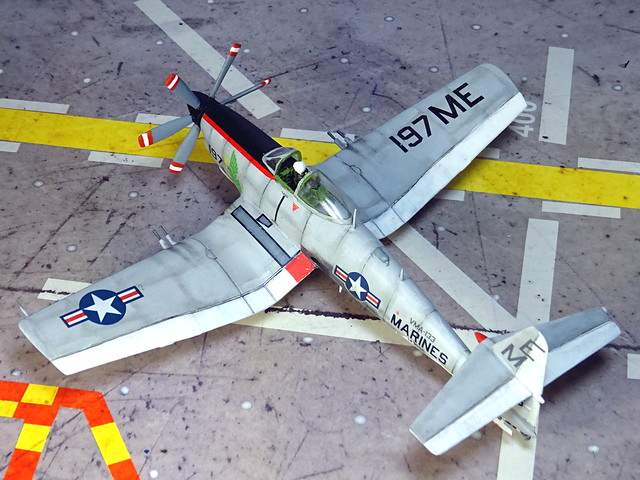Dieses "Ding" ist eher evolutionär entstanden - am Anfang stand die Diskussion über turboprop-betriebene Varianten von WWII-Veteranen, und als ich anfing eine simple F4U-5 mit einer T-56-Turbine (aus Resin, aus einem Umrüstsatz für eine C-130J) auszustatten, kam eins zum anderen. Und irgendwann war von der Corsair dank Spenderteilen und chirurgischen Eingriffen nicht mehr viel übrig, so dass das Ding "A3U Sea Scorpion" umgetauft werden
musste.




Some background:The US Marine Corps' lessons learned from the Korean war included the need for a ground attack aircraft with a better performance than the AU-1 Corsair, as well as a higher effectiveness than the jet fighters of the 50ies era.
The AU-1 (re-designated from F4U-6) had been a dedicated U.S. Marines attack variant of the Vought F4U fighter with extra armor to protect the pilot and fuel tank, and the oil coolers relocated inboard to reduce vulnerability to ground fire. The fighter's supercharger had been simplified as the design was intended for low-altitude operation. Extra weapon racks were also fitted.


Ready for combat the AU-1 weighed 20% more than a fully loaded F4U-4 and was capable of carrying 8,200 lb of bombs, missiles or drop tanks. The AU-1 had a maximum speed of 238 miles per hour at 9,500 ft, when loaded with 4,600 lb of bombs and a 150-gallon drop-tank. When loaded with eight rockets and two 150-gallon drop-tanks, maximum speed was 298 mph at 19,700 ft. When not carrying external loads, maximum speed was 389 mph at 14,000 ft.
First produced in 1952, the AU-1 had been a useful addition. But it had become clear, by the end of the Korean War, that the age of the piston engine fighter plane was more or less over. Based on this insight and several studies based on the experience since WWII, Vought offered the USMC an improved ground attack aircraft on a private venture basis under the internal project handle V-381. The machine was the result of initial attack aircraft studies and roughly based on the F4U's outlines, and a more conservative alternative to the A2U, a proposed attack derivative of the F7U Cutlass, which never came to fruition.


The V-381 study incorporated proven elements like the characteristic inverted gull wing, which allowed a short and sturdy landing gear, but it differed considerably in many other details and its internal structure, due to a different engine. The aircraft was to be powered by a T-56 turboprop engine and would fit into a heavier class than the F4U, rather comparable to the US Navy's AD Skyraider but almost as fast as a jet fighter of its time – yet more reliable and rugged for low level operations in direct range of small caliber weapons.
The USMC was immediately interested, while the USN declined the proposal (even though much of the V-381’s insights were re-used in the V-406). Compared with the AU-1, the XA3U featured many detail improvements. One of these distinctive modifications was a new cockpit with a bubble canopy. Thanks to the different internal layout of the aircraft the cockpit could be moved forward by about 3', eliminating the abysmal field of view from the F4U's cockpit on the ground and during deck landings. Another significant change was a cruciform tail. This new arrangement had become necessary in order to avoid damage and turbulences from the hot turboprop efflux - the latter's exhaust was bifurcated and placed in the fuselage flanks, slightly deflected downwards and right at the wings' trailing edge, where the residual thrust from the engine helped during liftoff. The characteristic tail arrangement also became the source of the aircraft's official name, the 'Sea Scorpion'.

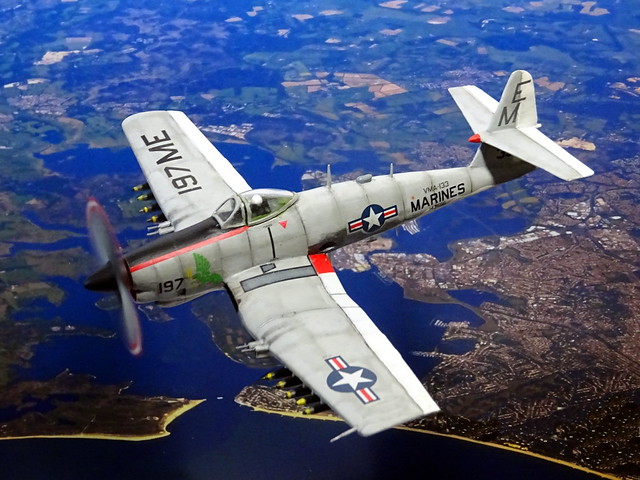
Armament consisted of four 0.79 in (20 mm) M2 cannon with 250 RPG in the wings, plus a total of fifteen hardpoints under fuselage and wings for a wide range of ordnance and a total weight of 8,000 lb (3,600 kg). The landing gear retracted backwards into the wings, rotating 90°, and the tail wheel with an attached arrester hook was fully retractable, too. The T-56 turboprop with 4.050 hp (2.977 kW) replaced the R-2800 radial and its complex compressor installment, driving a four-blade Hamilton propeller on the XA2U.
In June 1954 the first XA3U prototype made its maiden flight. Initial flights tests showed a very good performance at low and medium altitude, but directional stability was rather poor and the fin area had to be enlarged, resulting in the X3AU-1. Another new feature became a reversible six blade propeller of smaller diameter, which would improve reaction time to throttle input. In this guise, the A3U-1 entered series production and USMC service in early 1956, just in time to take the place of the AU-1 which was phased out in 1957.
But, by that time, the technical development had already rendered the A3U at least questionable, if not obsolete, so only a single batch of 45 aircraft was ordered and eventually built. Types like the North American FJ-4 Fury or the Douglas A4D Skyhawk offered a better performance as well as a nuclear strike capability that the A3U lacked, even though the turboprop aircraft was popular because of its ruggedness and good low altitude handling.


With its sophisticated design the A3U served well in its intended shipborne CAS role. In 1958 the machines were upgraded to carry AGM-12 Bullpup missiles, becoming subsequently designated A3U-2. Up to four missiles could be carried under the wings, plus a guidance pod that was carried on one of the outermost wing hardpoints.
The A3Us were deployed during several occasions, including Cuba from 1959 to 1960 to protect Americans during the Cuban Revolution, Thailand in May-July 1962 to support the government's struggles against Communists as well as Operation Power Pack in 1965 in Haiti to prevent a second Communist nation on America's doorstep. Anyway, no A3U actually fired in anger, their main task had rather been sabre-rattling and representing the USMC with dramatic weapon loads at low altitude. Since ever more potent aircraft entered the USMC, like the F-4 Phantom II, the Sea Scorpion's career ended already in 1968 – and despite its usefulness in the theatre of operations, the A2U was not deployed to Vietnam


General characteristics: Crew: 1 pilot
Length: 33 ft 8 in (10.2 m)
Wingspan: 41 ft 0 in (12.5 m)
Wingspan, folded: 17 ft 0.5 in (5.2 m)
Height: 14 ft 9 in (4.50 m)
Empty weight: 11,968 lb (5,429 kg)
Loaded weight: 18,106 lb (8,213 kg)
Max. takeoff weight: 25,000 lb (11,340 kg)
Powerplant: 1× Allison T-56-A-6 turboprop engine, rated at 4.050 hp (2.977 kW)
plus approximately 750 lbs of thrust from the exhaust
Performance: Maximum speed: 446 mph (717 km/h) at 26.200 ft (using emergency power)
Stall speed: 89 mph (143 km/h) clean
Range: 1,316 mi (1,144 nmi, 2,115 km) on internal fuel
Service ceiling: 41,500ft (12,649 m)
Rate of climb: 3,870ft/min (19.7 m/s) at sea-level
Armament: 4 × 0.79 in (20 mm) M2 cannon with 250 RPG in the wings
15 hardpoints for a total of up to 8,000 lb (3,600 kg) of ordnance, including bombs,
torpedoes, mine dispensers, unguided rockets, and gun pods
Wie erwähnt war das mal eine F4U-5 von Italeri. Neben der schmaleren Turbinen-Nase habe ich über eckige Tragflächenenden nachgedacht, dann über eine erhöhte Höhenruder-Position wegen der Abgase und ein nach vorne versetztes Cockpit... eins kam zum anderen!
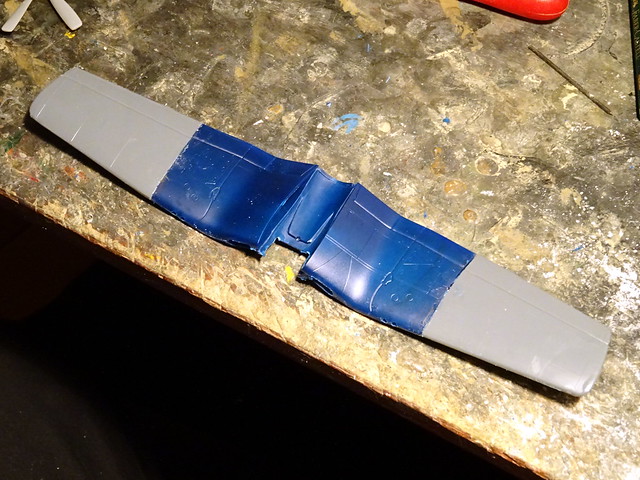
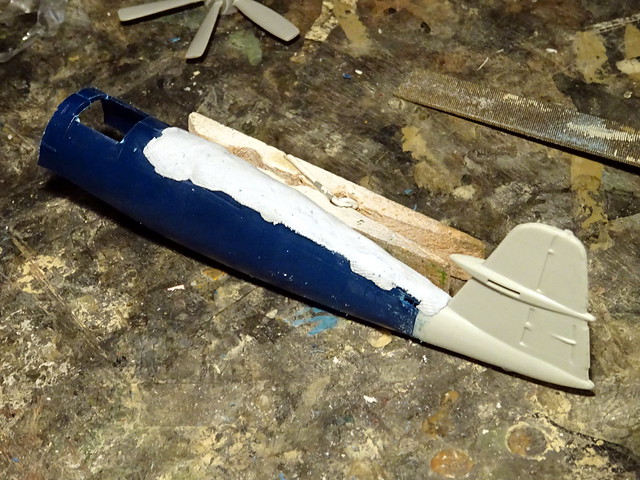
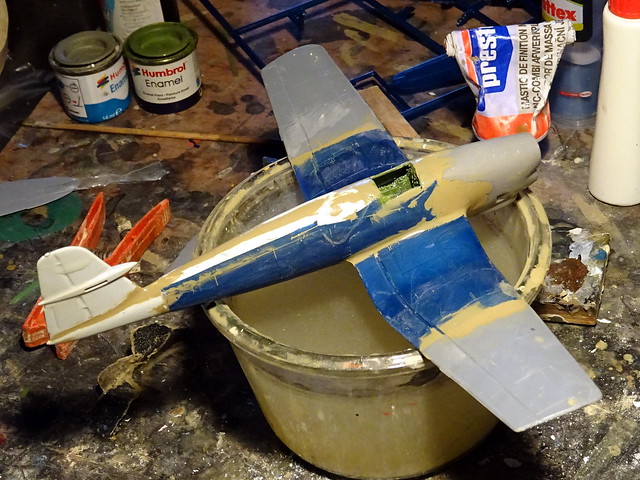

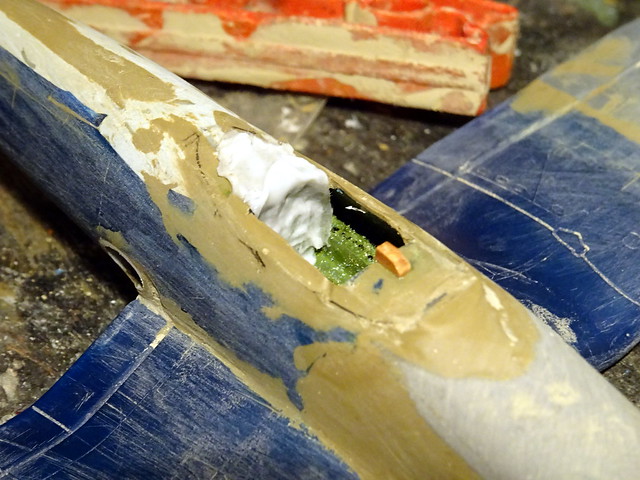

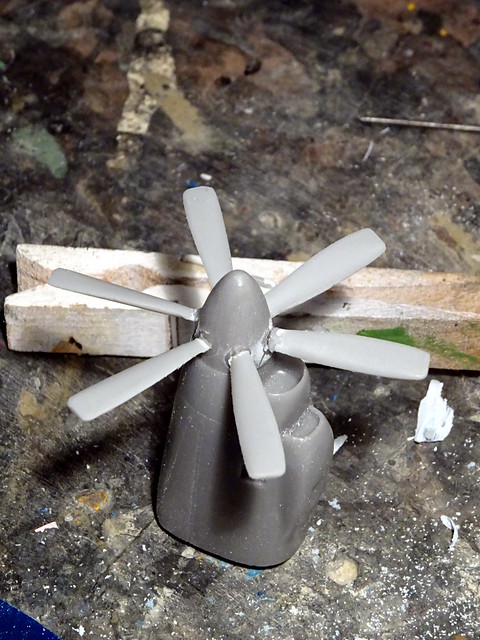
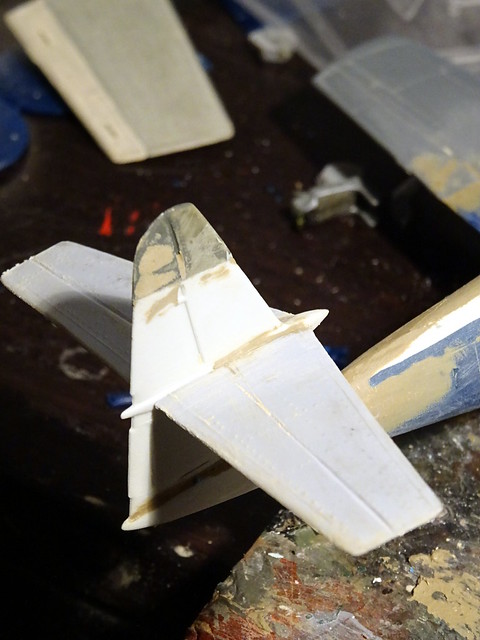
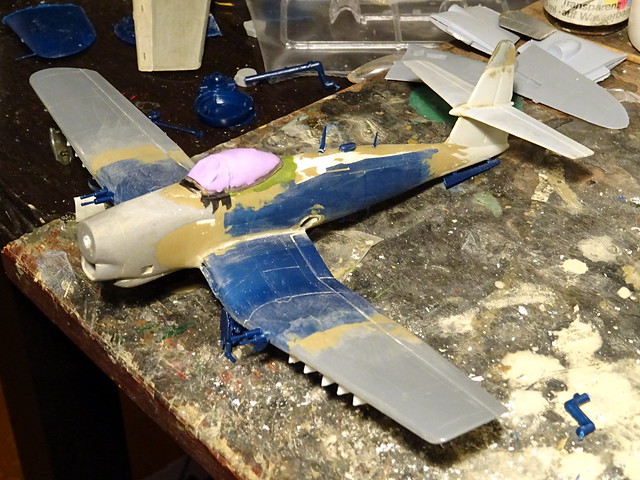
Viel Spenderteile wurden verwendet, so stammt die Haube von einer 1:72 Supermarine Attacker von Novo und die Höhenruder sind eigentlich Tragflächenenden einer 1:100 Breguet Alizé von Heller. Das Heck stammt von einem A.W. Meteor Nachtjäger von Matchbox, wobei die Spitze nach verlängert und der Heckrad-Schacht versetzt wurde.
Die Lackierung ist konservativ, entsprechend realer Vorbilder aus der Zeit. Da beim Bau viele Oberflächendetails verschollen gegangen sind wurden Panel Lines mit Bleistift (8B, Vollfettstufe, der malt sogar auf Glas!

) aufgemalt und mit Panel-Shading und einem Tuschewashing etwas Kontrast ergänzt. Die Aufkleber sind aus diversen Quellen zusammengepuzzelt.

